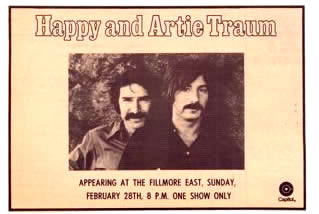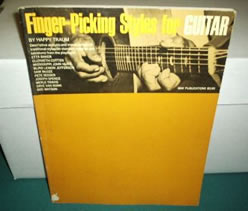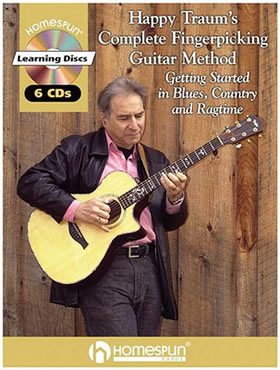
A Conversation with
Happy Traum
Puremusic: Homespun Tapes seems to have been around about as long as I can recall.
Happy Traum: Well, next year we're coming into our 40th year since we first made our very first audiotapes.
PM: Unbelievable! I don't know how many products there are, but this morning, I believe I counted 256 artists, alone, that were represented.
HT: Yeah, something like that. I don't know the exact number myself, but it's in that realm.
PM: Astounding. So with whom, and what, did the catalog begin, and what prompted the initiative to begin with?
HT: Well, it started when I was a guitar teacher in New York City in those days.
PM: Out of the house, or at one of the--
HT: Both. I had done different things. I had students who came to my house and I was teaching at different music facilities.
PM: At Matt Umanov's or somebody like that?
HT: Well, not Umanov's in those days, but there was a place called Noah Wolf, a guitar shop in midtown Manhattan, I taught there. And there were some music schools I taught at part-time. I was just making a living, running around being a guitar teacher when I wasn't playing music, which I had also been doing for a while before that. And then, around the middle '60s, my brother Artie and I started to get together and go out and do some gigs and go on the road together.

PM: Right. Yeah, certainly our family was big fans of that duo.
HT: Uh-huh? Oh, okay. First we had a rock 'n' roll band for a couple of years, called The Children of Paradise. Then I moved to Woodstock and the fact of the matter was that I couldn't keep up with my students anymore, so I got the idea of making tapes for them so they'd have something to work on when I wasn't around to teach them. But making individual tapes for individual students got to be too much work. It was just a much bigger job than I had hoped.
PM: Right, too custom.
HT: Yeah. I had written a book that had come out a year or two previous, called Fingerpicking Styles for the Guitar.

PM: And was that an Oak Publications book?
HT: That's right, Oak Publications. And it did very well. It was the first of its kind. Nobody had ever transcribed traditional guitar solos note for note.
PM: Amazing.
HT: So that was popular. Then what happened was I decided, well, what if I made a series of tapes. I thought I would base my first tapes on the book, which was primarily what I was teaching anyway. So I put together twelve lessons on tapes--they were reel-to-reel tapes, you have to realize. There weren't even cassettes then.
PM: [laughs] Reel-to-reel tapes!
HT: Yeah, reel-to-reel, little five-inch reels. And I just made this series of twelve lessons, and started sending them to my students. And then I put ads in places like Sing Out! magazine. And Guitar Player magazine was just getting started around that time, so I put a few ads there, and began getting a response.
PM: Wow.
HT: Since I got a response to that, I made a couple of other lessons. And then I thought, I have all these great musician friends in Woodstock who I play with all the time, why don't I just get them to make lessons, too. So I got Bill Keith, the great banjo player who had just moved to Woodstock from the Boston area, and a guy named David Cohen--he had just quit playing with Country Joe and the Fish, and moved to Woodstock. He was their original and only keyboard player, so he made some piano tapes for us. It was all very home done, just a little home tape recorder, nothing fancy, with a mic or two set up just in my living room, and I just brought people in. And Kenny Kosek, the great fiddler--
PM: Sure, I remember him.
HT: He came up and did some fiddle stuff for us. So it was one of these things that just started snowballing. In the early days, it was just personal friends who were great musicians I was calling on. And then, of course, I was adding all the time, myself, to these tapes. My brother also made some tapes for us.
So then it kind of progressed that way. I started going further afield and finding musicians that I didn't necessarily know personally, but that I admired.
PM: Who played different styles, et cetera.
HT: Right. I started getting into bluegrass. Well, this is already in the '70s by this time, and I must have met them at festivals. I met Sam Bush--he was just a kid at the time.
PM: And was already great.
HT: Yeah, already great. So I got him to do some--these are all audio tapes, still. Then I got Tony Rice. People like that just started saying yes to me. I was amazed that they said yes, but they did.
PM: And would you bring them all up to Woodstock, or record them on the fly, or--
HT: No, I recorded them all different places. Whenever I could, I brought them to Woodstock; that was the easiest for me. But I recorded my lessons with Tony Rice out in California where he was living at the time. For Sam Bush, I went to Kentucky and recorded in a little cabin in Bowling Green, Kentucky, so I went and hung out with him. I went to Louisiana to record Michael Doucet, the great Cajun fiddler from BeauSoleil.
PM: You must have felt like Alan Lomax or something.
HT: Well, in some ways, yeah, it was a little bit like that, because I was getting to hang out in these kind of exotic places--exotic for me--and hanging out with these great guys, most of whom I became good friends with. That was the nicest thing, that we had a great relationship develop outside of the business part of it.
So I continued doing that, and then in around 1983, video started coming into the picture.
print (pdf) listen to clips puremusic home
